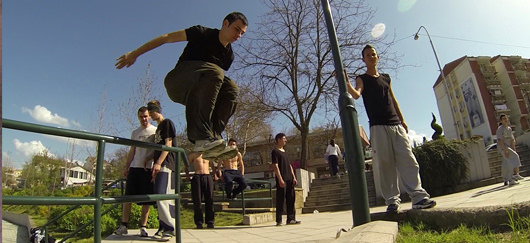How to Use Lucid Dreaming for Self Improvement
I practice parkour. It's a discipline in which you press against your fear and comfort zones, pushing yourself to do bigger jumps around scarier obstacles.
Much of the time you're physically prepared and your technique is flawless - but the barriers you face are in your mind. Fear is holding you back, stifling your energy to prevent you from hurting yourself.

At one time I had a certain obstacle that I was trying to overcome for four full training sessions. I wanted to jump from one obstacle over another one and then land on a small concrete wall that wasn't visible until I was mid-air.
If I jumped with my full power I could hurt myself - so my brain would always unconsciously limit the power of my jump so that I would land on the obstacle I was supposed to jump over. Even though I was 100% certain that I was physically ready, something would take over in the last second before the jump and make me fail.
I tried visualizations, affirmations, small step progressions and other techniques but nothing seemed to work.
Using Dreams for Self Improvement
When you have something on your mind for a longer time you are likely to dream about it. So after a while I found myself in a dream, doing the same jump, going through the whole movement, feeling the perfect timing of each muscle activation and landing on the concrete wall over the obstacle that I almost started to hate.
I remembered this dream, and on the next training I recalled it instead of using normal visualizations. The memory of me doing the move was much more vivid and evoked stronger emotions in me, a small shift happened and I felt absolutely certain that I would make it. Moments later I was standing, triumphant, on the concrete wall in real life.
Now, the four training sessions, other visualization techniques and years of training did most of the work and I am not saying it was all down to the dream. But it did push my confidence further so I could commit 100% to making the jump.
And once I did it, I could do it again and again and again. Once the barrier was broken, the next jump just got easier.
This experience got me thinking…
Could you deliberately use lucid dreaming as a tool for building specific simulated experiences that would help you get the much needed confidence boost in real life..?
Visualizations in Lucid Dreams
Performing visualizations inside a lucid dream can be more powerful than visualizing while awake. That's because:
- Your mind is isolated from distractions and outside influences.
- Your body and mind are in a state of deep relaxation.
- Dreams are a state in which your unconscious is more receptive.
This technique can be used to combine multiple self help techniques in a single lucid dream. It can also be used to recreate real-world situations and simulate successful scenarios.
These dreams can be custom-made for our specific needs, they can hit us on multiple levels, and they can give us exactly what we need to feel empowered to face our real life challenges.
In waking life, instead of visualizing our goals or using affirmations, we can just recall our engineered dream - and it will automatically bring the emotions associated with it.
However because the engineered dream is a powerful experience, the mere act of remembering the dream will also have greater impact than a waking visualization. Here's how to do it.

How to Engineer a Lucid Dream Storyline
This technique is not set in stone, but it has worked effectively for me in the past. Feel free to modify and change it to your personal needs. Adapt what is useful, reject what is useless, and add what is specifically your own.
- Be specific. A lucid dream created for a specific goal, around a specific theme, will have a greater impact in waking life. For example if you want the courage to ask for a pay rise, create a dream where you talk with your boss about exactly that, instead of a random scenario that builds courage.
- Be detailed. More details make the experience stronger, so the clearer the lucid dream visualization the better. The same goes for normal visualizations, so if you have experience, apply the same principle here.
- Use real-world objects, people, places and situations. Whenever you can, draw on objects from your real life. Even mundane or trivial details will help align the visualization with your real-world experience, making it more real... and more powerful.
- Develop detailed dream recall. A greater dream memory means you'll be able to harness this technique as a more effective self-development tool. The more detailed the recall, the stronger the effect.
Creating a Lucid Dream Storyline for Improving Your Public Speaking Skills
Here's an example of the technique in action:
Become lucid, stabilize the dream, and increase the vividness. (For tips on this front, see How to Stay Lucid and Increase Your Lucidity.)
Go to the exact place where you are supposed to deliver your speech in real life. But before walking out on the stage, bring to mind all the details about the room and the people inside, like some of the people you know might be watching.
Before going out, give yourself a boost with a few affirmations of confidence (they should be super strong in a lucid dream) and also become amused about what's going to happen next.
Finally, go out and deliver your perfect speech. Ask questions, tell jokes and engage the audience, simulating the whole thing with all the details. Your engineered lucid dream is complete!
There. You have gone through the experience and it's now an actual memory. You will feel that you have done it in the past and you can always recall that memory to give yourself a boost when you need it.
How to Use Lucid Dreaming for Long Term Goals
There are some challenges that require your commitment for months or even years. How do you create a storyline for this?
Fortunately, time in lucid dreams is relative, and we can engineer lucid dreams in which we feel like we have lived an entire life...
For example, let's say that you have the goal of losing 20 pounds.
You can fast forward through time in your dream, six months in the future. See your dream self eating the right foods, being super dedicated, working out regularly, getting much needed sleep, and so forth.
Another method is to travel forward in time and talk to your future healthy self. Let him tell you the great story of his (your) success.
After you've done this, you should have a much clearer picture about how it feels to have gone through the transformation and how you would actually look. But the best thing is that you now have the feeling that you have done it in the past - and the confidence associated with this will help you get the same results in waking life.
Now, the next time you go to the gym, just remember your dream and you'll get a psychological boost. You'll remember the plan, you'll get the confidence boost and you will also receive the positive emotions associated to your future image.
Even if the memory is not technically real, the emotions behind it are... and that is what truly matters.

About The Guest Author
Aleksandar Atanasoski is a lucid dreamer from Macedonia. He has been passionate about the subject since he began conscious dreaming in 2010.
















